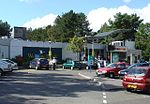Hart District

Hart is a local government district in Hampshire, England, named after the River Hart. Its council is based in Fleet. It was formed on 1 April 1974 under the Local Government Act 1972, as a merger of the urban district of Fleet, and the Hartley Wintney Rural District. It was named the best place to live in the UK in the 2017 Halifax quality of life study.Hart District is one of the richest and least deprived areas in the whole of the United Kingdom. In the Indices of Deprivation 2015, Hart was ranked at 326 out of 326 local authorities in England, where 1 was the most deprived area and 326 the least deprived, meaning Hart is the least deprived area in England.For five years running (2011-2015), an annual study conducted by the Halifax bank named Hart as the UK's most desirable place to live for quality of life. The study took into account jobs, housing, health, crime, weather, traffic and broadband access. It found that in 2014 97% of people in the local authority area were in good health, and in 2011 tended to have incomes 40% above the national average.
Excerpt from the Wikipedia article Hart District (License: CC BY-SA 3.0, Authors, Images).Hart District
Harlington Way, Hart Fleet
Geographical coordinates (GPS) Address Nearby Places Show on map
Geographical coordinates (GPS)
| Latitude | Longitude |
|---|---|
| N 51.2794 ° | E -0.8461 ° |
Address
Council Offices
Harlington Way
GU51 4ZU Hart, Fleet
England, United Kingdom
Open on Google Maps





